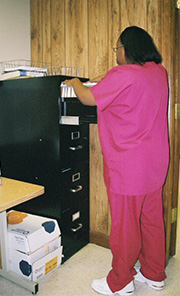What is Ms. Valens’s role as a school nurse?
Page 2: Provides Health Services for Students with Disabilities
As you read on the previous page, school nurses have numerous responsibilities related to the healthcare of students in their charge. In addition to providing services that promote general health for the entire school population, they also provide more intensive health services to students with disabilities.
Array of Services
 For students with disabilities, the school nurse may offer a continuity of healthcare services related to each student’s needs. The amount of time that a school nurse spends in a school might range from one hour per week to full-time. Similarly, the school nurse may provide a broad range of services, which may include providing or coordinating one-to-one care to a single child throughout the school day. Healthcare services for students with disabilities requiring special healthcare needs might include:
For students with disabilities, the school nurse may offer a continuity of healthcare services related to each student’s needs. The amount of time that a school nurse spends in a school might range from one hour per week to full-time. Similarly, the school nurse may provide a broad range of services, which may include providing or coordinating one-to-one care to a single child throughout the school day. Healthcare services for students with disabilities requiring special healthcare needs might include:
- Administering medication (e.g., prescription medication for attention deficit hyperactivity disorder)
- Managing chronic conditions (e.g., asthma)
- Caring for and monitoring students with intravenous medication, gastrostomy (feeding) tubes, tracheostomies, and ventilators
- Helping students, such as those in wheelchairs, with toileting needs
- Inserting urinary catheters
Increase in the Need for School Nurses
The need for these more intensive services has grown over the past several decades. More and more, the school nurse’s technical expertise is essential to educators as they work together to meet the learning and health needs of students with disabilities. Some children with disabilities need more complex health services, such as urinary catheterization and gastrostomy tube feedings, in order to attend school with their peers.
Did You Know?
Many schools do not have a nurse on staff! For the 52 million students in the United States, there is just one nurse for every 1,300 students. However, NASN recommends the following ratio of school nurses to students.
| Recommended ratio for nurses to students: | |
| General population | 1:750 |
| Students with disabilities included in general education classes | 1:225 |
| Students who are severely disabled or chronically ill | 1:125 |
| Students who are medically fragile | Based on individual need |
(NASN, 2004b)
This table displays the NASN’s recommended ratios for school nurses to students in different disability (or non-disabled) categories. For the general school population, NASN recommends one nurse for every 750 students. For students with disabilities included in general education classes, NASN recommends one nurse for every 225 students. For students who are severely disabled or chronically ill, NASN recommends one nurse for every 125 students. Finally, in the case of students who are medically fragile, NASN recommends that the number of nurses be based on the students’ individual needs.
For more than a decade, there has been an increase in the number of students attending school who require health-related services. The reasons for this are many, but include legal mandates, medical advances, and changing expectations.
| Legal Mandates | ||||||||
Legislative changes have brought about an increase in the number of students with more severe disabilities attending public schools. Many such children, who previously were educated separately in either institutions or special education buildings, are now mainstreamed or included in educational settings with their non-disabled peers. Some of these students may have severe developmental delays or health-related issues and require more assistance than in years past.
|
||||||||
| Medical Advances | ||||||||
| In addition, advances in technology have allowed more children with complex health issues to attend school with their non-disabled peers. For example, medical advances have allowed premature babies to survive from earlier stages than was possible in years past, the result of which has been more children with complex health issues attending school. Moreover, medical advances enable children who are medically fragile to live longer and participate in school longer. | ||||||||
| Changing Expectations | ||||||||
| As a result of changing attitudes in American society, school nurses are called upon to provide primary medical care for many children. An increasing number of parents now expect schools to assume responsibility for their children’s overall well-being, including his or her physical, social, and mental health. School nurses are often asked to perform routine healthcare screenings and provide advice or referrals. In addition, children of immigrant families, who have limited English-language skills, frequently use the school nurse as an entry point into the healthcare system. |
In providing care to students, school nurses (and all school personnel) must be mindful of legislation that protects the privacy of students. School nurses should:For Your Information